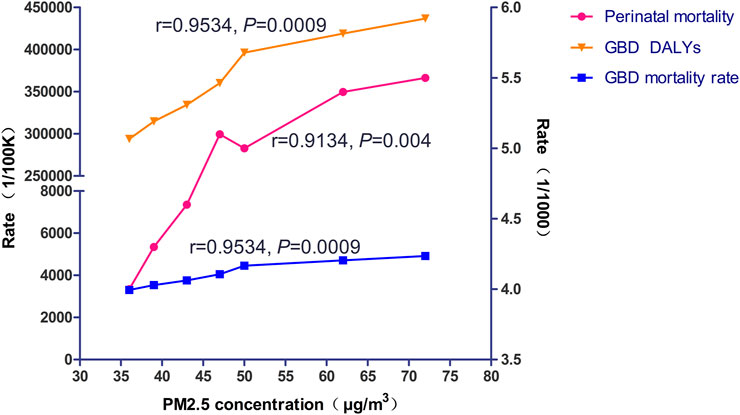- 1School of Public Health, Health Science Center, Xi’an Jiaotong University, Xi’an, China
- 2Department of Pediatrics, The Second Affiliated Hospital of Xi’an Jiaotong University, Xi’an, China
Background: Air pollution exposure is an environmental risk to public health. And the available data on relationships of air pollution and neonatal disease burden are scarce. This study assessed neonatal disease burden attributable to Particulate Matter 2.5 (PM 2.5) pollution in China.
Methods: This is a retrospective analysis with data from the GBD2019 database. Data of PM 2.5 pollution exposure levels and neonatal disease burden attributable to PM 2.5 in China from 1990 to 2019 were obtained from the Global Burden of Disease Study 2019 (GBD 2019); Data of PM2.5 concentration was collected from the Bulletin of the State of the Ecological Environment in China; Data of perinatal mortality was collected from the Chinese Maternal and Child Health Surveillance Network. Deaths, Disability-adjusted life years (DALYs), Year of life lost (YLLs), and Years lived with disability (YLDs) are primary indicators used to assess neonatal diseases burden. The correlation of PM2.5 pollution and neonatal death was analyzed. Average Annual Percentage Change (AAPC) and increment were used to assess exposure levels and disease burden trends.
Results: PM 2.5 pollution exposure level of newborns in China is much higher than global average, 32.08 per 100 people (95% UI: 26.57–38.06) in 2019 compared to 1990 (15.86 per 100 people, 95% UI: 6.83–30.88), with an increase of 102.27%. And it is statistically verified PM2.5 concentration was positively correlated with neonatal disease deaths (r = 0.9534, p = 0.0009) and DALYs (r = 0.9534, p = 0.0009). The overall disease burden of neonatal diseases attributed to PM 2.5 pollution in China has decreased from 1990 to 2019, with a decrement of 5738.34 deaths (decreased: 56.85%), 51.01 person/years (decreased: 56.84%) for DALYs, 51.23 person/years (decreased: 57.11%) for YLLs and an increase of 150.69 person/years (increased: 31.71%) for YLDs.
Conclusion: There exists positive correlation between environmental pollution and neonatal diseases in China. The number of neonatal disease deaths, DALYs, and YLLs due to PM 2.5 pollution showed a decreasing trend with the environmental pollution control. For the rising YLDs, there is a need to improve survival rates while focusing on prognosis of neonatal disease and reducing the burden of disease brought on by disability. Controlling environmental pollution is likely to help reduce neonatal disease burden, especially premature birth and neonatal encephalopathy.
Introduction
Newborns’ first 28 days of life (neonatal period) are the most vulnerable period for a child’s survival, with approximately 2.5 million children dying each year in the first month of life (EF et al., 2017). Newborns may suffer from various diseases in this stage, such as prematurity, neonatal encephalopathy, jaundice, and sepsis. The main causes of newborns’ death are preterm birth and intrapartum-related complications and infections, such as sepsis, meningitis, and pneumonia. The global neonatal mortality rate decreased from 3.66% in 1990 to 1.80% in 2017, with China decreasing from 2.95% in 1990 to 0.47% in 2017. In the United States, the neonatal mortality rate decreased from 0.58% in 1990 to 0.36% in 2017, while in Japan, it decreased from 0.25% in 1990 to 0.09% in 2017. In 2017, neonatal diseases were ranked ninth in the YLL ranking of the 25 leading causes of death of newborns in China (Zhou et al., 2019). Neonatal diseases are complex, and the mortality rate has decreased significantly with the development of medical and neonatal care; however, the potential for developmental disability cannot be ignored. The impact of neonatal disease on quality of life increases the burden of disease.
Air pollution has a negative impact on human health. Particulate Matter 2.5 (PM 2.5) is one of the main air pollutants. It has been shown that PM 2.5 pollution impacts maternal health during pregnancy and affects the outcome of birth, especially the birth weight and the preterm birth (Jacobs et al., 2017). Ambient particulate matter pollution was one of the top 4 risk factors for deaths and DALY percentages in China in 2017 where age-standardized Summary Exposure Values (SEV) have increased from 1990 to 2017, which is the largest change of age-standardized SEV among the top 10 risk factors in China (Zhou et al., 2019). The Chinese government has been actively combating air pollution over the past few years; even PM 2.5 pollution has been controlled strictly and its concentration has decreased obviously. Moreover, the long-term average absolute level of air pollution in China is still high, and the burden of disease due to those air pollution has decreased, but some areas are still on the rise (Huang et al., 2018; Yin et al., 2020; Zhang et al., 2021).
In recent years, the health effects of air pollution on newborns have received increasing attention. Therefore, this study aimed to assess the burden of neonatal diseases caused by PM 2.5 pollution in China from 1990 to 2019. Furthermore, to understand more systematically the burden of neonatal diseases attributable to PM 2.5 pollution in China and explore the pattern of change over the past 30 years; And the analysis results will provide a basis for rational allocation of health resources and the formulation of health policies.
Materials and Methods
Data Sources
The 2019 Global Burden of Disease (GBD) project comprehensively assesses the disease burden for 87 risk factors in 204 countries and territories worldwide. The GBD publishes data on attributable mortality, disability-adjusted life years (DALYs), years of life lost (YLLs), and years lived with disability (YLDs) data. The current data is given for 1990–2019 (Murray et al., 2020). YLL was estimated by multiplying the estimated number of deaths by the patient’s age with the standard life expectancy at that corresponding age. The YLD due to disease-induced disability was estimated by multiplying the disease prevalence with different disability weights, and the DALY was obtained by summing YLD and YLL (Liu et al., 2019). The rates were all age-standardized using the world standard population developed by the GBD research (Feigin et al., 2015).
In the GBD database, the primary data used to estimate mortality in China were obtained from the Chinese Center for Disease Control and Prevention, the Chinese Disease Surveillance Point System (DSPs), the Chinese Maternal and Child Health Surveillance Network, the Chinese Health Statistical Yearbook, and data from published and unpublished studies and reports (Luo et al., 2017). The GBD PM2.5 values were derived from the integration of satellites combined with a chemical transport model, surface measurements, and geographical data at a 0.1° × 0.1° (approximately 11 km × 11 km at the equator) resolution, and then aggregated to national-level population-weighted means to produce a national exposure estimate (Brauer et al., 2016; Cohen et al., 2017; Liu et al., 2021).
Data Analysis Parameters
The data used in this study was obtained from GBD 2019 through the Global Health Data Exchange query tool (GHDx, http://ghdx.healthdata.org/gbd-results-tool) with data refinement distinguishing between years, genders, attributions, and ages (Liu et al., 2021). The PM2.5 exposure data and the neonatal disease burden data attributable to PM2.5 from 1990 to 2019 were extracted from the GHDx. Deaths, DALYs, YLLs, and YLDs, were the main indicators used to assess the disease burden in newborns. Neonatal diseases are divided into five categories: neonatal preterm birth, neonatal encephalopathy due to birth asphyxia and trauma, hemolytic disease, neonatal jaundice, neonatal sepsis, and other neonatal infections and disorders.
The data on China’s PM2.5 concentration comes from the Bulletin of the State of the Ecological Environment in China issued by the Ministry of Ecology and Environment of the People’s Republic of China (https://www.mee.gov.cn/). The data on perinatal mortality in China comes from the Chinese Maternal and Child Health Surveillance Network (http://www.mchscn.cn/).
Statistical Analysis
The annual percentage change (APC) and average annual percentage change (AAPCs) were used to evaluate the change trend of PM2.5 exposure from 1990 to 2019. APCs were used to detect specific segments of the linear trend throughout the study. AAPCs were used to estimate the overall change. APC, AAPC, and its 95% CI were calculated using Joinpoint Regression Program 4.9.0.0, and differences were considered significant at p < .05.
GraphPad prism 5 was used to plot the figures and describe population exposure levels of PM2.5 pollution and its changes in China and globally from 1990 to 2017. And Pearson Correlation was analyzed to directly explore the correlation between PM2.5 pollution concentration and the neonatal death rate, also used to analyze the current level of mortality and disease burden attributable to PM 2.5 pollution among Chinese newborns from 1990 to 2019, as well as the magnitude of their changes.
Results
Trends in PM 2.5 Exposure of the Whole Population
The PM 2.5 SEV in Global whole population increased from 15.65 (95% UI:10.62–21.58) per 100 population in 1990 to 26.22 (95% UI:21.57–30.50) per 100 population in 2019. Although a decreasing trend was observed from 2015 to 2017, the global average exposure level of PM 2.5 steadily increased between 1990 and 2019, with an increase of 71.20%. The global AAPC in PM 2.5 exposure level was 1.8% (95% CI: 1.7–1.9%) with an overall increasing trend. There existed a fastest increasing period from 2006 to 2014, with a statistically significant APC of 3.0% (95% CI: 2.9–3.1%).
Conversely, the PM 2.5 SEV in whole population of China was 16.92 (95% UI: 7.57–30.64) per 100 population in 1990, which is close to the global SEV, but has been increasing since then at a much higher rate than the global average. The SEV value increased to 37.57 (95% UI: 31.94–43.25) per 100 population in 2019, with a downward trend starting in 2015; however, an overall upward trend of 133% was observed from 1990 to 2019 and has remained high compared to the global average. The AAPC of PM 2.5 exposure level in China was 2.8% (95% CI: 2.6–2.9%). An overall increasing trend with the fastest increasing period being from 1995 to 1999 with an APC of 4.6% (95% CI: 3.5–5.7%) and a decreasing trend in 2014–2019 with an APC of −1.4% (95% CI: −1.9-0.9%), which was statistically significant (Tables 1, 2; Figure 1).
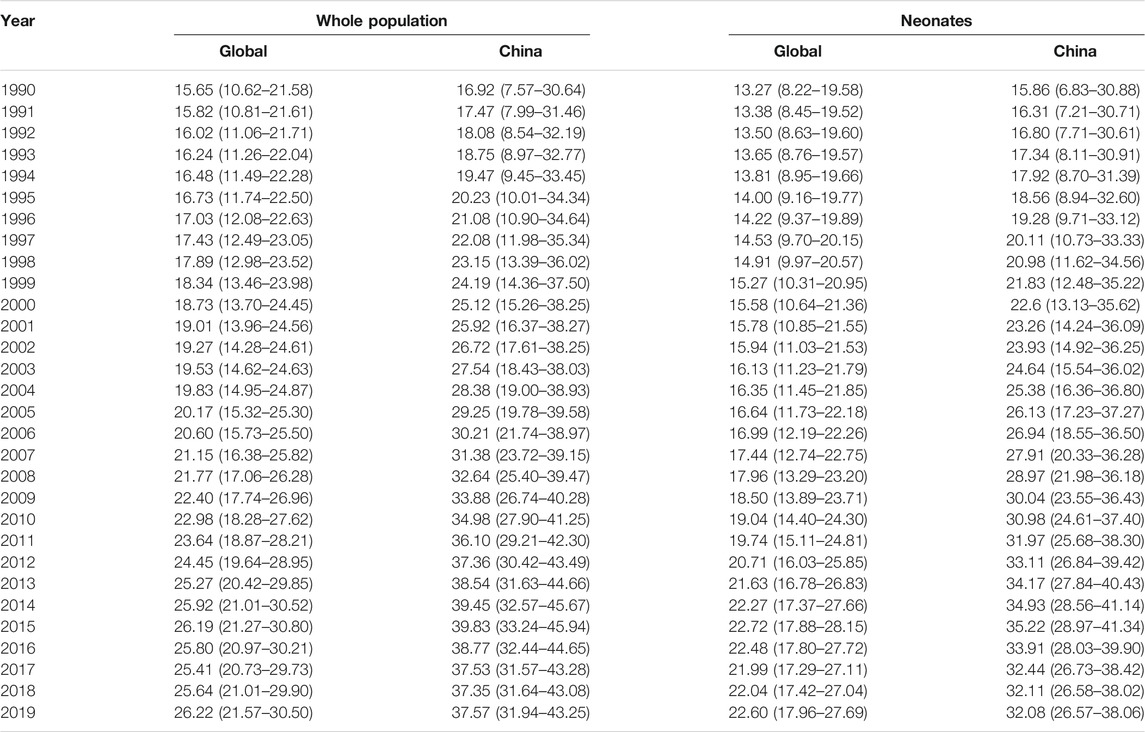
TABLE 1. Trends in PM 2.5 exposure of the whole population globally and in China from 1990 to 2019 (SEV, 95%UI).
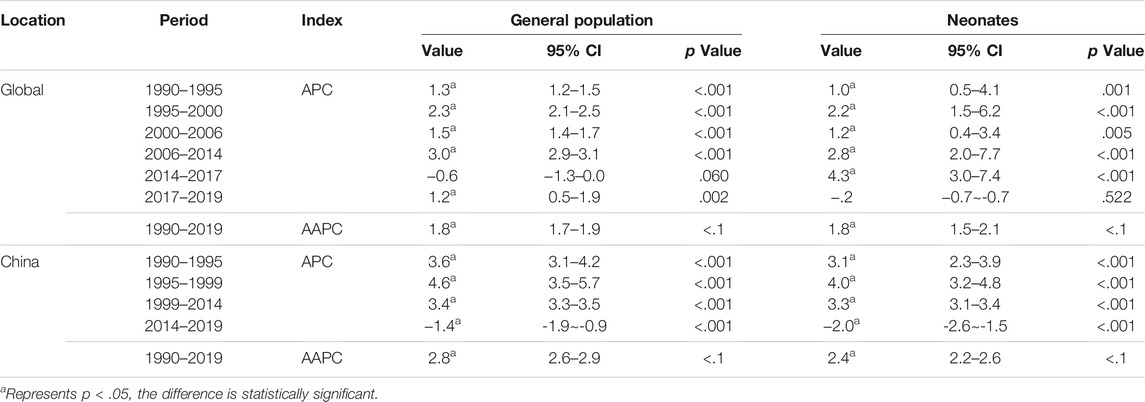
TABLE 2. The analysis of trends in PM 2.5 exposure of the whole population globally and in China from 1990 to 2019 according to the APC and the AAPC.
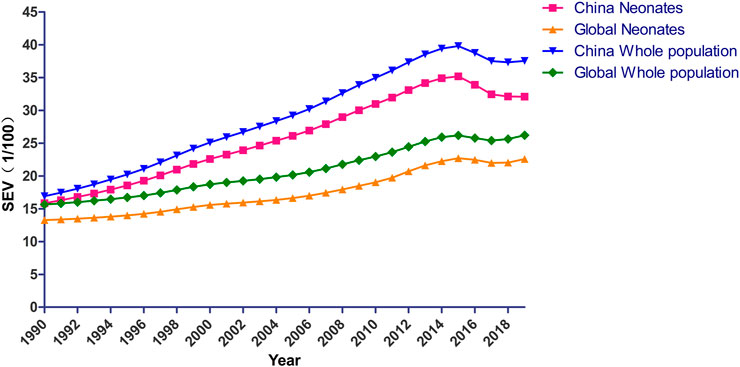
FIGURE 1. Trends in PM 2.5 exposure of the whole population and newborns globally and in China from 1990 to 2019.
Trends of Neonatal PM 2.5 Exposure Levels
The PM 2.5 SEV in Global newborns population increased from 13.27 (95% UI:8.22–19.58) per 100 people in 1990 to 22.60 (95% UI:17.96–27.69) per 100 people in 2019. The average exposure level showed an overall upward trend from 1990 to 2019 with an increase of 71.11%. The global AAPC in neonatal PM 2.5 exposure levels was 1.8% (95% CI: 1.5–2.1%). An overall increasing trend with the fastest increasing period being from 2010 to 2014 with a statistically significant APC of 4.3% (95% CI: 3.0–7.4%).
PM 2.5 exposure levels among Chinese newborns increased from 16.88 (95% UI: 7.55–30.62) per 100 people in 1990 to 32.08 (95% UI:26.57–38.06) per 100 people in 2019. A downward trend began in 2015; however, the overall trend over the period of 1990–2019 showed an upward trend with an increase of 102.27% and was beyond the global average. The mean AAPC in PM 2.5 exposure levels for newborns in China was 2.4% (95% CI: 2.2–2.6%). An overall increasing trend with the fastest increasing period from 1994 to 1999 with an APC of 4.0% (95% CI: 3.2–4.8%) and a decreasing trend from 2014 to 2019 with an APC of - 2.0% (95% CI: 2.6% to −1.5%), which is statistically significant. (Tables 1, 2; Figure 1).
Correlation Analysis Between PM2.5 Concentration and Neonatal Disease Burden
The PM2.5 concentration is positively correlated with the burden of neonatal disease by Pearson Correlation analysis, showing that the data in GBD is consistent with the data from the China Maternal and Child Health Surveillance Network. Data from GBD shows that both neonatal disease deaths (r = 0.9534, p = 0.0009) and DALYs (r = 0.9534, p = .0009) in China are positively correlated with PM2.5 concentrations. Data obtained from the Chinese Maternal and Child Health Surveillance Network shows that the perinatal mortality rate is positively correlated with the concentration of PM2.5 (r = 0.9134, p = .004) (Figure 2).
Neonatal Disease Burden Attributable to PM 2.5 Pollution in China
From 1990 to 2019, the overall neonatal disease deaths, DALYs, and YLLs due to PM 2.5 pollution in China showed a decreasing trend, while YLDs showed an increasing trend (Figure 2). Compared to 1990, the number of deaths in 2019 decreased by 5738.34 cases, which is a decrement of 56.85%; DALYs decreased by 51.01, which is a decrement of 56.84%; YLLs decreased by 51.23, a 57.11% drop, and the YLDs increased by 150.69, which is an increment of 31.71%. Moreover, compared to 1990, the number of deaths, DALYs, and YLLs for all types of neonatal diseases attributed to PM 2.5 pollution in China in 2019 decreased to various degrees, as shown in Table 3. YLDs indicators revealed a different scenario with increases of 5.31 person/years (1.8% increase), 116.81 person/years (188.01% increase), and 38.47 person/years (64.33% increase) for preterm birth, sepsis, and other infections and neonatal diseases, respectively; however, decreases of 8.58 person/years (26.88% decrease) and 1.32 person/years (4.98% decrease) for neonatal encephalopathy and hemolytic disease and jaundice, respectively were observed.
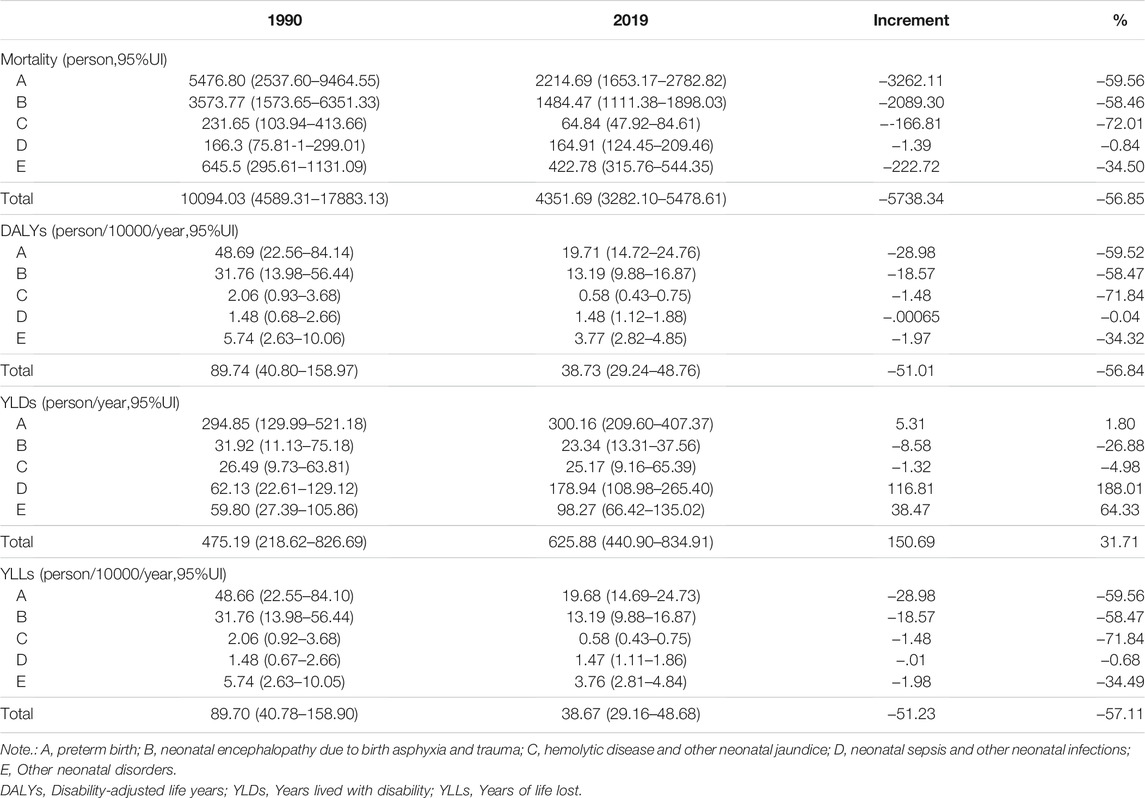
TABLE 3. Neonatal disease burdens (in mortality, DALYs, YLDs, and YLLs) attributable to PM 2.5 exposure in China in 1990 and 2019.
Mortality rate, DALY, YLL, and YLD rate of preterm neonatal birth due to PM 2.5 pollution in China in 1990 and 2019 is the highest among all types of neonatal diseases. Neonatal encephalopathy has the second highest mortality rate, DALY, and YLL. Sepsis and other infections had the second highest rate of YLD (Table 4).

TABLE 4. Different neonatal disease burdens and the rank in mortality, DALY, YLD, and YLL attributable to PM 2.5 exposure in China in1990 and 2019 (rate/100k).
The overall disease burden indicators for male infants are slightly higher than for female infants. The number of cases of death in 2019 was 2533.45 and 1818.24 for males and females, respectively. The mortality rates for males and females were 413.50 per 100K, and 346.58 per 100K, respectively. The DALYs were 225,449.84 person/years and 161,856.02 person/years for males and females, respectively (Figure 3). The burden of neonatal diseases attributable to PM 2.5 pollution in China decreases year to year, but the most predominant neonatal diseases are still preterm birth and neonatal encephalopathy (Figure 4).
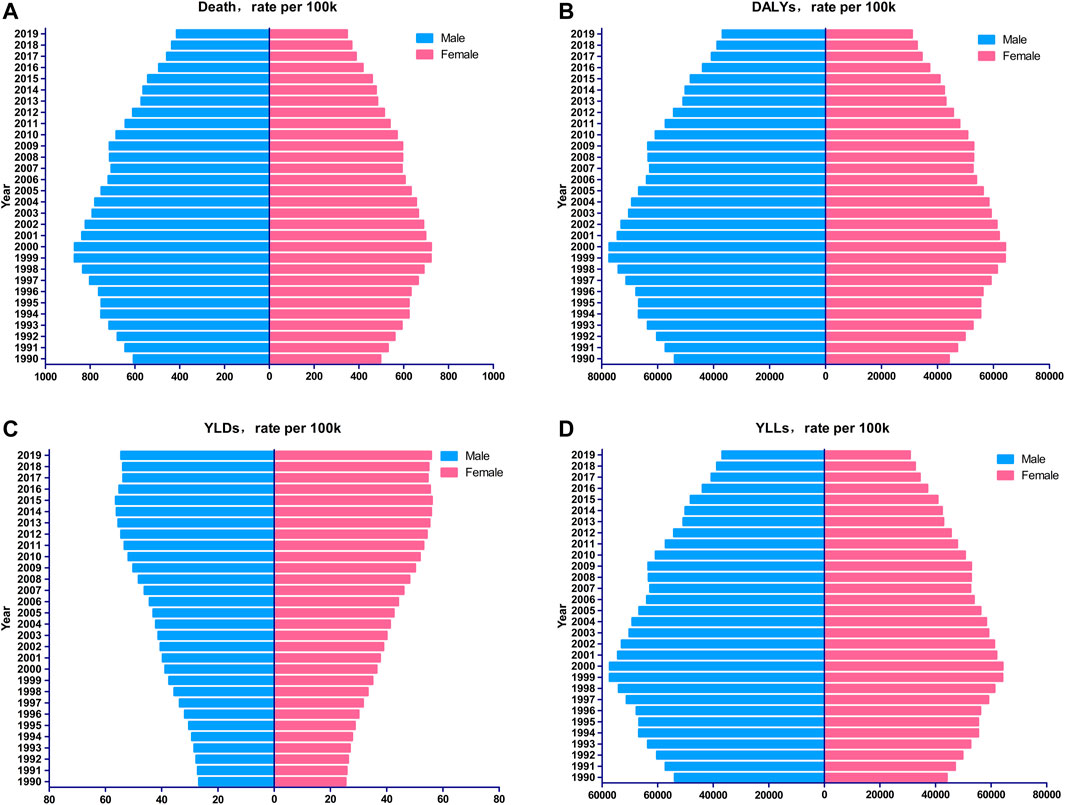
FIGURE 3. The trends of neonatal disease burdens attributable to PM 2.5 exposure in China from 1990 to 2019 [(A), mortality; (B), DALYs; (C), YLDs; (D), YLLs].
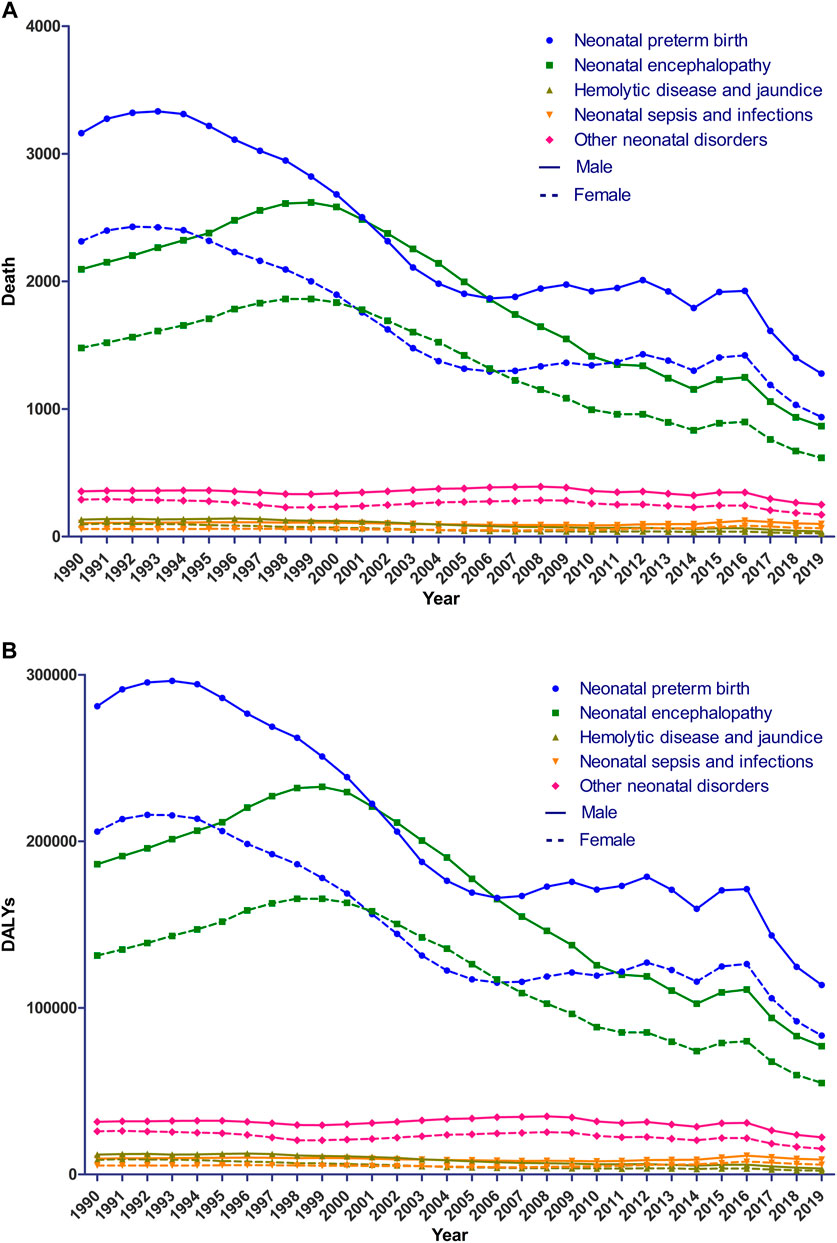
FIGURE 4. The trends of different neonatal disease burdens in different genders attributable to PM 2.5 exposure in China from 1990 to 2019 [(A), mortality; (B), DALYs].
Discussion
As the source of various health problems, numerous scientific studies have explained the environmental risk to public health caused by particle exposure. And the available data on the relationships of particulate matter air pollution and neonatal disease burden, particularly in China, are scarce. This study assessed neonatal disease burden of attributable to PM 2.5 pollution in China from 1990 to 2019 using data related to PM 2.5 pollution exposure and neonatal disease obtained from the GBD research.
In this study, PM 2.5 pollution exposure levels among Chinese newborns were much higher than the global average and more than doubled in 2019 compared to 1990. Environmental PM2.5 concentration is positively correlated with neonatal disease burden. Though the overall disease burden of neonatal diseases attributed to PM 2.5 pollution in China has decreased from 1990 to 2019. Deaths, DALYs, and YLLs, decreased to various degrees, but YLDs for preterm birth, sepsis, and other infections and other neonatal diseases showed varying degrees of increase, which deserved more attention.
The global number of deaths attributable to PM 2.5 exposure in 2015 was 4.2 million, with 1.1 million deaths coming from China, accounting for more than a quarter of all deaths caused by PM 2.5 exposure. The mortality rate attributable to PM 2.5 pollution in China was 84.3 per 100K, more than four times that of the United States 18.5 per 100K people (Cohen et al., 2017). Globally, more than 250 million people live in highly polluted areas, primarily in east-central China and the Ganges Plains of India (Cheng et al., 2016). In 2013, China implemented the Action Plan for the Prevention and Control of Air Pollution, focusing on treatment mainly in the eastern and central regions (Huang et al., 2018). There is a decreasing trend of PM 2.5 exposure among Chinese newborns in 2014–2019 with an APC of–2.0% (95% CI: –2.6% to –1.5%, p < .001)., and there is a decreasing trend of mortality of neonatal diseases attributable to PM 2.5 in 2015–2019 with an APC of –6.4% (95% CI: –7.7% to –5.1%, p < .001). This study shows that the PM 2.5 exposure levels in China slowed down after 2013 and declined in 2015. Furthermore, the disease burden attributable to PM 2.5 pollution among newborns has also shown a significant decrease, However, China still has a severe PM 2.5 pollution problem and needs to further intensify its treatment and control efforts to reduce the damage of PM 2.5 pollution on population health.
Our research verified the data obtained in China and the GBD data, and the results showed that PM2.5 pollution does have a certain relationship with the burden of neonatal disease. One study found that short-term exposure to PM 2.5 adversely affects neonatal and postnatal mortality, specifically mortality related to respiratory causes (Yorifuji et al., 2016). A strong association between PM 2.5 and infant mortality has also been demonstrated for neonatal mortality in low- and middle-income countries (Anwar et al., 2019; Goyal et al., 2019). Several studies have also shown that PM 2.5 exposure during pregnancy or the postpartum period has adverse effects on neonatal health and results in adverse outcomes such as preterm birth, low birth weight, neonatal death, and impaired lung development (Proietti et al., 2013; Gauderman et al., 2015; Korten et al., 2017; Smith et al., 2017; Heft-Neal et al., 2018; Zhang et al., 2019; Macchi et al., 2021).
The leading causes of neonatal death are prematurity, birth-related complications, and infections such as sepsis, meningitis, and pneumonia. According the estimates from World Health Organization (WHO), 35% of all neonatal deaths in 2017 were due to complications of prematurity, 24% of deaths were related to delivery (intrapartum events), such as birth asphyxia, and 14% of deaths were due to sepsis or meningitis (Hug et al., 2019). From 1990 to 2017, there has been a significant improvement in neonatal survival globally, a 51% reduction in neonatal mortality, and a reduction in deaths from 5 million to 2.5 million per year (Hug et al., 2019). Despite this, 2.5 million newborns died in 2017 alone, with significant variation in neonatal mortality across regions and countries.
Preterm birth is an important global health issue. An estimated 15 million neonates are born preterm each year, and the rate of preterm birth has been steadily increasing worldwide (Blencowe et al., 2012). The World Health Organization’s Birth Too Soon: Global Action Report on Preterm Birth, released on 02 May, 2012, states that 15 million preterm babies are born worldwide each year with more than 1 million dying soon after birth. Those who survive often endure a lifetime of accompanying illness (Hua et al., 2015). Preterm birth complications are the leading cause of death in children under 5 years of age. Approximately 1 million people died worldwide in 2015 (Liu et al., 2016). Air pollution has been shown to influence preterm birth (Sun et al., 2015; Li et al., 2017; Guan et al., 2019; Wang et al., 2020). This study shows that China has the highest mortality and disease burden of preterm births attributable to PM 2.5 pollution, with 197,100 person/years for DALYs, 300.16 person/years for YLDs, and 196,800 person/years for YLLs. It is suggested that the main contribution to the disease burden attributable to PM 2.5 neonatal preterm birth in China is currently YLL. Therefore, it is vital to target preterm birth complications with the necessary interventions to reduce deaths due to preterm birth.
Neonatal sepsis is an acute infectious disease with a very high morbidity and mortality rate. The widespread application of antibiotics has led to a significant increase in drug-resistant strains of pathogenic bacteria (Jia et al., 2017). In 2019, the rate of neonatal sepsis and other infectious diseases YLD attributed to PM 2.5 pollution ranked second, increasing 142.31% compared to 1990. The death rate was the fourth highest, with a reduction of 14.29% compared to 1990. The results show that the burden of disability caused by neonatal sepsis is increasing, suggesting that early diagnosis, timely and rational antimicrobial drug treatment, as well as attention to its treatment prognosis leading to the possibility of disability should be achieved.
With improvements in obstetric and neonatal care, the number of children who survived high-risk neonatal illness with neurodevelopmental disorders and disabilities has increased. The risk of having at least one impairment during development after a perinatal injury is estimated to be approximately 40% (Kohli-Lynch et al., 2019). Sometimes, improper application of technical interventions, such as induction of labor without adequate monitoring during labor, may result in a higher incidence of injured survivors. In these settings, YLDs accounts for a larger proportion of the total DALYs (21% in East Asia/Pacific and Middle East/North Africa, and 9% in sub-Saharan Africa/South Asia) (Lee et al., 2013). This study found that the number of neonatal disease deaths, DALYs, and YLLs due to PM 2.5 pollution in China decreased from 1990 to 2019, while YLDs increased by 31.71% in 2019 compared to 1990. Developmental disabilities caused by neonatal diseases increase the burden of disease. It is suggested that reducing the burden of disease in the neonatal stage requires not only improving neonatal survival but also requires further attention. Moreover, we need to focus on the prognosis of neonatal diseases, paying attention to child developmental issues, and reducing the burden of disease caused by disability.
There have certain limitations in our research for using the available database. The data of PM2.5 concentration in China and the data of perinatal mortality in China are not detailed enough, and there are differences in the spatial distribution. Further cohort studies are needed to verify the relationship between PM2.5 pollution and neonatal disease burden.
Conclusion
This study assessed neonatal disease burden of attributable to PM 2.5 pollution in China from 1990 to 2019 using data related to PM 2.5 pollution exposure and neonatal disease obtained from the GBD research. The results show a high level of PM 2.5 pollution exposure in China. Environmental PM2.5 concentration is positively and strongly correlated with neonatal disease burden. With the control of PM2.5 pollution, although the burden of disease of newborns is reducing, the burden of disease caused by disability is increasing, which indicates that the long-term effects of PM2.5 exposure may contribute to the disability of newborns. The results of our study suggest that various measures should continue to be taken to improve air quality, and focus on the prognosis and developmental disabilities during improving the neonatal survival.
Data Availability Statement
The original contributions presented in the study are included in the article/Supplementary Material, further inquiries can be directed to the corresponding authors.
Author Contributions
All authors contributed to data interpretation, wrote and revised various parts of the paper. JY, LS, HL, and YC conducted the work presented here and performed data analysis; JY and BH drafted the manuscript. LZ, JZ, and YC revised the overall paper; YC and BH supervised the work. All authors read and approved the final manuscript.
Funding
This work was financially supported by the National Natural Science Foundation of China (82173526), and the Natural Science Basic Research Plan of the Shaanxi Province (2020JQ-547). The funding body played no role in the design of the study, in the collection, analysis, and interpretation of data, or in writing the manuscript.
Conflict of Interest
The authors declare that the research was conducted in the absence of any commercial or financial relationships that could be construed as a potential conflict of interest.
Publisher’s Note
All claims expressed in this article are solely those of the authors and do not necessarily represent those of their affiliated organizations, or those of the publisher, the editors and the reviewers. Any product that may be evaluated in this article, or claim that may be made by its manufacturer, is not guaranteed or endorsed by the publisher.
Acknowledgments
The authors thank AiMi Academic Services (www.aimieditor.com) for the English language editing and review services.
References
Anwar, A., Ayub, M., Khan, N., and Flahault, A. (2019). Nexus between Air Pollution and Neonatal Deaths: A Case of Asian Countries. Ijerph 16 (21), 4148. doi:10.3390/ijerph16214148
Blencowe, H., Cousens, S., Oestergaard, M. Z., Chou, D., Moller, A.-B., Narwal, R., et al. (2012). National, Regional, and Worldwide Estimates of Preterm Birth Rates in the Year 2010 with Time Trends since 1990 for Selected Countries: a Systematic Analysis and Implications. The Lancet 379 (9832), 2162–2172. doi:10.1016/s0140-6736(12)60820-4
Brauer, M., Freedman, G., Frostad, J., van Donkelaar, A., Martin, R. V., Dentener, F., et al. (2016). Ambient Air Pollution Exposure Estimation for the Global Burden of Disease 2013. Environ. Sci. Technol. 50 (1), 79–88. doi:10.1021/acs.est.5b03709
Cheng, Z., Luo, L., Wang, S., Wang, Y., Sharma, S., Shimadera, H., et al. (2016). Status and Characteristics of Ambient PM2.5 Pollution in Global Megacities. Environ. Int. 89-90, 212–221. doi:10.1016/j.envint.2016.02.003
Cohen, A. J., Brauer, M., Burnett, R., Anderson, H. R., Frostad, J., Estep, K., et al. (2017). Estimates and 25-year Trends of the Global burden of Disease Attributable to Ambient Air Pollution: an Analysis of Data from the Global Burden of Diseases Study 2015. The Lancet 389 (10082), 1907–1918. doi:10.1016/s0140-6736(17)30505-6
Feigin, V. L., Krishnamurthi, R. V., Parmar, P., Norrving, B., Mensah, G. A., Bennett, D. A., et al. (2015). Update on the Global Burden of Ischemic and Hemorrhagic Stroke in 1990-2013: The GBD 2013 Study. Neuroepidemiology 45 (3), 161–176. doi:10.1159/000441085
Gauderman, W. J., Urman, R., Avol, E., Berhane, K., McConnell, R., Rappaport, E., et al. (2015). Association of Improved Air Quality with Lung Development in Children. N. Engl. J. Med. 372 (10), 905–913. doi:10.1056/NEJMoa1414123
Goyal, N., Karra, M., and Canning, D. (2019). Early-life Exposure to Ambient fine Particulate Air Pollution and Infant Mortality: Pooled Evidence from 43 Low- and Middle-Income Countries. Int. J. Epidemiol. 48 (4), 1125–1141. doi:10.1093/ije/dyz090
Guan, T., Xue, T., Gao, S., Hu, M., Liu, X., Qiu, X., et al. (2019). Acute and Chronic Effects of Ambient fine Particulate Matter on Preterm Births in Beijing, China: A Time-Series Model. Sci. Total Environ. 650, 1671–1677. doi:10.1016/j.scitotenv.2018.09.279
Heft-Neal, S., Burney, J., Bendavid, E., and Burke, M. (2018). Robust Relationship between Air Quality and Infant Mortality in Africa. Nature 559(7713), 254–258. doi:10.1038/s41586-018-0263-3
Hua, S., Wei-wei, L., Hong-yan, Y., Mai-geng, Z., Shi-wei, L., and Yi-chong, L. (2015). Burden of Neonatal Diseases in China,1990-2010. DISEASE SURVEILLANCE 30 (08), 663–667.
Huang, J., Pan, X., Guo, X., and Li, G. (2018). Health Impact of China's Air Pollution Prevention and Control Action Plan: an Analysis of National Air Quality Monitoring and Mortality Data. Lancet Planet. Health 2 (7), E313–E323. doi:10.1016/s2542-5196(18)30141-4
Hug, L., Alexander, M., You, D., Alkema, L., Alkema, L., Black, R., et al. (2019). National, Regional, and Global Levels and Trends in Neonatal Mortality between 1990 and 2017, with Scenario-Based Projections to 2030: a Systematic Analysis. Lancet Glob. Health 7 (6), E710–E720. doi:10.1016/s2214-109x(19)30163-9
Jacobs, M., Zhang, G., Chen, S., Mullins, B., Bell, M., Jin, L., et al. (2017). The Association between Ambient Air Pollution and Selected Adverse Pregnancy Outcomes in China: A Systematic Review. Sci. Total Environ. 579, 1179–1192. doi:10.1016/j.scitotenv.2016.11.100
Jia, Z., Bi, F., and Zhang, C. (2017). Distribution and Drug Resistance of Pathogens Isolated from Neonates with Septicemia. Chin. J. Nosocomiology 27 (1), 197–200.
Kohli-Lynch, M., Tann, C. J., and Ellis, M. E. (2019). Early Intervention for Children at High Risk of Developmental Disability in Low- and Middle-Income Countries: A Narrative Review. Ijerph 16 (22), 4449. doi:10.3390/ijerph16224449
Korten, I., Ramsey, K., and Latzin, P. (2017). Air Pollution during Pregnancy and Lung Development in the Child. Paediatric Respir. Rev. 21, 38–46. doi:10.1016/j.prrv.2016.08.008
Lee, A. C., Kozuki, N., Blencowe, H., Vos, T., Bahalim, A., Darmstadt, G. L., et al. (2013). Intrapartum-related Neonatal Encephalopathy Incidence and Impairment at Regional and Global Levels for 2010 with Trends from 1990. Pediatr. Res. 74, 50–72. doi:10.1038/pr.2013.206
Li, X., Huang, S., Jiao, A., Yang, X., Yun, J., Wang, Y., et al. (2017). Association between Ambient fine Particulate Matter and Preterm Birth or Term Low Birth Weight: An Updated Systematic Review and Meta-Analysis. Environ. Pollut. 227, 596–605. doi:10.1016/j.envpol.2017.03.055
Liu, C., Wang, B., Liu, S., Li, S., Zhang, K., Luo, B., et al. (2021). Type 2 Diabetes Attributable to PM2.5: A Global burden Study from 1990 to 2019. Environ. Int. 156, 106725. doi:10.1016/j.envint.2021.106725
Liu, L., Oza, S., Hogan, D., Chu, Y., Perin, J., Zhu, J., et al. (2016). Global, Regional, and National Causes of Under-5 Mortality in 2000-15: an Updated Systematic Analysis with Implications for the Sustainable Development Goals. The Lancet 388 (10063), 3027–3035. doi:10.1016/s0140-6736(16)31593-8
Liu, W., Liu, J., Liu, J., Song, Y., Zeng, X., Wang, X., et al. (2019). Burden of Lymphoma in China, 2006-2016: an Analysis of the Global Burden of Disease Study 2016. J. Hematol. Oncol. 12 (1). doi:10.1186/s13045-019-0785-7
Luo, L., Jiang, J., Zhang, G., Wang, L., Wang, Z., Yang, J., et al. (2017). Stroke Mortality Attributable to Ambient Particulate Matter Pollution from 1990 to 2015 in China: An Age-Period-Cohort and Spatial Autocorrelation Analysis. Ijerph 14 (7), 772. doi:10.3390/ijerph14070772
Macchi, C., Iodice, S., Persico, N., Ferrari, L., Cantone, L., Greco, M. F., et al. (2021). Maternal Exposure to Air Pollutants, PCSK9 Levels, Fetal Growth and Gestational Age - an Italian Cohort. Environ. Int. 149, 106163. doi:10.1016/j.envint.2020.106163
Murray, C. J. L., Aravkin, A. Y., Zheng, P., Abbafati, C., Abbas, K. M., Abbasi-Kangevari, M., et al. (2020). Global burden of 87 Risk Factors in 204 Countries and Territories, 1990-2019: a Systematic Analysis for the Global Burden of Disease Study 2019. Lancet 396 (10258), 1223–1249. doi:10.1016/S0140-6736(20)30752-2
Proietti, E., Röösli, M., Frey, U., and Latzin, P. (2013). Air Pollution during Pregnancy and Neonatal Outcome: A Review. J. Aerosol Med. Pulm. Drug Deliv. 26 (1), 9–23. doi:10.1089/jamp.2011.0932
Smith, R. B., Fecht, D., Gulliver, J., Beevers, S. D., Dajnak, D., Blangiardo, M., et al. (2017). Impact of London's Road Traffic Air and Noise Pollution on Birth Weight: Retrospective Population Based Cohort Study. Bmj 359, j5299. doi:10.1136/bmj.j5299
Sun, X., Luo, X., Zhao, C., Chung Ng, R. W., Lim, C. E. D., Zhang, B., et al. (2015). The Association between fine Particulate Matter Exposure during Pregnancy and Preterm Birth: a Meta-Analysis. BMC Pregnancy Childbirth 15. doi:10.1186/s12884-015-0738-2
Wang, Q., Li, B., Benmarhnia, T., Hajat, S., Ren, M., Liu, T., et al. (2020). Independent and Combined Effects of Heatwaves and PM2.5 on Preterm Birth in Guangzhou, China: A Survival Analysis. Environ. Health Perspect. 128 (1), 017006–17006. doi:10.1289/EHP5117
Yin, P., Brauer, M., Cohen, A. J., Wang, H., Li, J., Burnett, R. T., et al. (2020). The Effect of Air Pollution on Deaths, Disease burden, and Life Expectancy across China and its Provinces, 1990-2017: an Analysis for the Global Burden of Disease Study 2017. Lancet Planet. Health 4 (9), E386–E398. doi:10.1016/s2542-5196(20)30161-3
Yorifuji, T., Kashima, S., and Doi, H. (20162002-2013). Acute Exposure to fine and Coarse Particulate Matter and Infant Mortality in Tokyo, Japan (2002-2013). Sci. Total Environ. 551-552, 66–72. doi:10.1016/j.scitotenv.2016.01.211
Zhang, L., Liu, W., Hou, K., Lin, J., Song, C., Zhou, C., et al. (2019). Air Pollution Exposure Associates with Increased Risk of Neonatal Jaundice. Nat. Commun. 10. doi:10.1038/s41467-019-11387-3
Zhang, M. J., Su, F. C., Xu, Q. X., Zhang, R. Q., Wei, Y., and Xie, L. Z. (2021). Health Impact Attributable to the Control of PM2.5 Pollution in China during 2013-2017. Huan Jing Ke Xue 42 (2), 513–522. doi:10.13227/j.hjkx.202007012
Keywords: particulate matter pollution, PM 2.5, neonates, disease burden, GBD2019
Citation: Yuan J, Shi L, Li H, Zhou J, Zeng L, Cheng Y and Han B (2022) The Burden of Neonatal Diseases Attributable to Ambient PM 2.5 in China From 1990 to 2019. Front. Environ. Sci. 10:828408. doi: 10.3389/fenvs.2022.828408
Received: 03 December 2021; Accepted: 17 January 2022;
Published: 07 February 2022.
Edited by:
Qiyuan Wang, Institute of Earth Environment (CAS), ChinaReviewed by:
Richard Ménard, Environment and Climate Change, CanadaXiao-San Luo, Nanjing University of Information Science and Technology, China
Copyright © 2022 Yuan, Shi, Li, Zhou, Zeng, Cheng and Han. This is an open-access article distributed under the terms of the Creative Commons Attribution License (CC BY). The use, distribution or reproduction in other forums is permitted, provided the original author(s) and the copyright owner(s) are credited and that the original publication in this journal is cited, in accordance with accepted academic practice. No use, distribution or reproduction is permitted which does not comply with these terms.
*Correspondence: Yue Cheng, Y2hlbmd5QG1haWwueGp0dS5lZHUuY24=; Bei Han, aGFuYmVpQG1haWwueGp0dS5lZHUuY24=
 Jia Yuan
Jia Yuan Lu Shi
Lu Shi Hongbo Li1
Hongbo Li1 Yue Cheng
Yue Cheng Bei Han
Bei Han